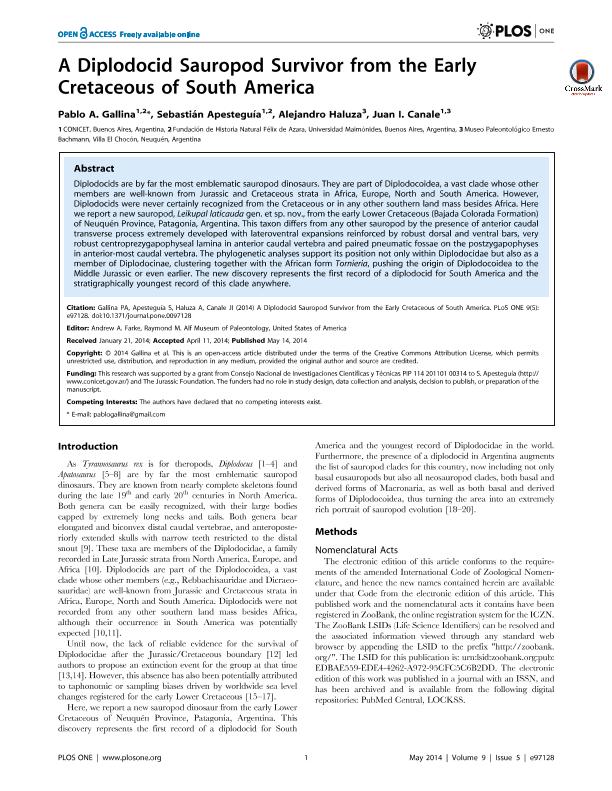Artículo
A Diplodocid Sauropod Survivor from the Early Cretaceous of South America
Fecha de publicación:
05/2014
Editorial:
Public Library Of Science
Revista:
Plos One
ISSN:
1932-6203
Idioma:
Inglés
Tipo de recurso:
Artículo publicado
Clasificación temática:
Resumen
Diplodocids are by far the most emblematic sauropod dinosaurs. They are part of Diplodocoidea, a vast clade whose other members are well-known from Jurassic and Cretaceous strata in Africa, Europe, North and South America. However, Diplodocids were never certainly recognized from the Cretaceous or in any other southern land mass besides Africa. Here we report a new sauropod, Leikupal laticauda gen. et sp. nov., from the early Lower Cretaceous (Bajada Colorada Formation) of Neuque ´ n Province, Patagonia, Argentina. This taxon differs from any other sauropod by the presence of anterior caudal transverse process extremely developed with lateroventral expansions reinforced by robust dorsal and ventral bars, very robust centroprezygapophyseal lamina in anterior caudal vertebra and paired pneumatic fossae on the postzygapophyses in anterior-most caudal vertebra. The phylogenetic analyses support its position not only within Diplodocidae but also as a member of Diplodocinae, clustering together with the African form Tornieria, pushing the origin of Diplodocoidea to the Middle Jurassic or even earlier. The new discovery represents the first record of a diplodocid for South America and the stratigraphically youngest record of this clade anywhere.
Palabras clave:
Diplodocidae
,
South America
,
Early Cretaceous
,
Leinkupal
Archivos asociados
Licencia
Identificadores
Colecciones
Articulos(CCT - PATAGONIA NORTE)
Articulos de CTRO.CIENTIFICO TECNOL.CONICET - PATAGONIA NORTE
Articulos de CTRO.CIENTIFICO TECNOL.CONICET - PATAGONIA NORTE
Articulos(SEDE CENTRAL)
Articulos de SEDE CENTRAL
Articulos de SEDE CENTRAL
Citación
Gallina, Pablo Ariel; Canale, Juan Ignacio; Haluza, Alejandro; Apesteguía, Sebastián; A Diplodocid Sauropod Survivor from the Early Cretaceous of South America; Public Library Of Science; Plos One; 9; 5-2014; 1-9
Compartir




